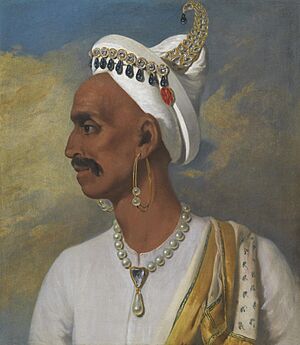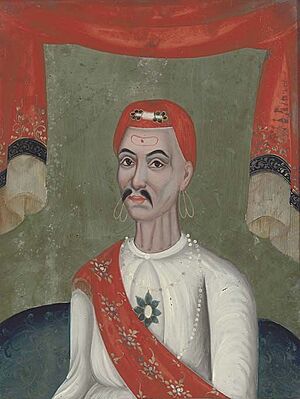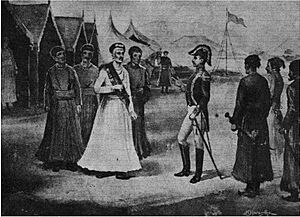Nana Fadnavis facts for kids
Quick facts for kids Nana Fadnavis |
|
|---|---|

Portrait of Nana Fadnavis by John Thomas Seton
|
|
| Born | Balaji Janardan Bhanu 12 February 1742 Satara, Maratha Empire (Modern-day Maharashtra, India) |
| Died | 13 March 1800 (aged 58) Pune, Maratha Empire (Modern day Maharashtra, India) |
| Religion | Hinduism |
| Occupation | Prominent minister and statesman of the Maratha Empire during the Peshwa administration |
Nana Fadnavis (born Balaji Janardan Bhanu) was a very important minister and leader in the Maratha Empire in India. He lived from 1742 to 1800. People in Europe sometimes called him "the Maratha Machiavelli" because he was very clever at politics and managing the state.
Early Life and Rise to Power
Balaji Janardan Bhanu was born in 1742 in a family called Chitpavan Brahmin in Satara. His nickname was 'Nana'. His grandfather, Balaji Mahadaji Bhanu, had moved from a village called Velas. The Bhanu family had a close friendship with the Bhat family, who were the Peshwas (like prime ministers) of the Maratha Empire.
Nana's grandfather once saved the Peshwa from a dangerous plot. Because of this, the Peshwa asked Chattrapati Shahu to give the Bhanu family the title of 'Phadnavis'. A Phadnavis was a main minister who handled important jobs like administration and finance for the Maratha Empire. Nana inherited this important role and continued to be the finance minister for the Peshwa. He was treated like family by the Peshwa and received excellent education and training in diplomacy.
Leading the Maratha Empire
In 1761, Nana escaped from the Third Battle of Panipat. After this, he became a very powerful person in the Maratha Confederacy. Even though he was not a soldier, he helped guide the Maratha state. This was a time when leaders changed quickly, and there was a lot of political trouble. Nana Phadnavis was crucial in keeping the Maratha Confederacy united. He also worked to stop the growing power of the British East India Company.
Nana was very skilled in managing the government, dealing with other countries, and handling money. His skills brought wealth to the Maratha Empire. He also kept the British East India Company from taking over Maratha lands. He helped the Maratha forces win battles against the Nizam of Hyderabad, Hyder Ali, and Tipu Sultan of Mysore. He also fought against the English Army.
After Peshwa Narayanrao was killed in 1773, Nana Phadnavis took charge of the state. He did this with a group of twelve leaders called the Barabhai council. This council was Nana's idea to protect Madhavrao II. Madhavrao II was Narayanrao's son, born after his father's death. The council helped prevent fights within the Peshwa family. The Barabhai Council was a group of powerful generals led by Nana. During this time, the Maratha Empire was very large and powerful. Many smaller states were under its protection.
In 1798, Nana was suddenly arrested while visiting a camp. This led to a lot of chaos and looting in Pune. He was released a few months later. Nana became ill and died in Pune on March 13, 1800. After his death, the new Peshwa, Baji Rao II, relied on the British. This led to the Second Anglo-Maratha War, which caused the Maratha Confederacy to break apart.
In 1768, Nana Phadnavis was given the village of Menavali. He developed the village and built a beautiful complex there. This included a large mansion called a Wada, steps leading down to the Krishna river called a Ghat, and two temples. One temple was for Lord Vishnu, and the other for Lord Shiva. This combination of a mansion, a riverfront, and temples was common during the Peshwa era. However, most of these grand structures are no longer well-preserved.
The Nana Phadnavis Wada in Menavali is special because it is still in excellent condition. It is a large building with six courtyards and a strong protective wall. This complex was finished around 1780.
After Nana Phadnavis died in 1800, the Peshwa Baji Rao II took over the wada. But later, Governor-General Wellesley returned the property to Nana's wife, Jeeubai. After her death, the property was given to Nana's descendants. Today, the Nana Phadnavis wada is still owned by his family.
Ghats, which are steps leading to a river, became more complex during the Peshwa era. They had different areas for bathing, washing, and religious ceremonies. Temples were often built right on these ghats.
Nana, as the Peshwa's 'Phadnavis', kept important documents and letters. These documents, known as the "Menavli Daptar," were stored in the wada at Menavali.
The wada has a secret, narrow staircase hidden inside a thick wall. This staircase leads to Nana Phadnavis's main reception hall. The hall has a bedroom with a beautiful wooden bed.
The Meneshwar temple at the wada has a very large bell, weighing 650 kilograms. This bell was taken by Bajirao I's brother, Chimaji Appa, from a Portuguese fort in 1707. It has a picture of Mary carrying baby Jesus on it. There is also a very old, large tree with a platform around it, which is as old as the wada itself. This tree was even featured in the Bollywood movie Swades.
Many Bollywood movies have been filmed at the wada because of its unique and historic look. Some of these movies include Yudh, Mrityudand, Jis Desh Mein Ganga Rehta Hain, Gangaajal, and Swades.






